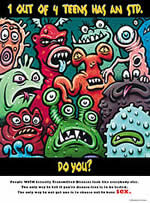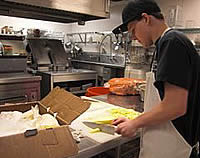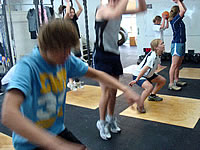
By Julie Kippenbrock, 16, and Laura Cockman, 17, Y-Press
INDIANAPOLIS, IN—The health of young people is always a cause for concern, whether it be childhood obesity, tobacco and alcohol use, teen pregnancy or serious automobile accidents. These issues, which the government finds most important to address, are important to youth, too, but young people find other matters pressing as well.
Click here to read these profiles:
Colorado Organization for Latina Opportunity and Reproductive Rights (COLOR)
Denver, CO
Students Against Destructive Decisions (SADD)
Nationwide
The PEACH Club
Worcester, MA
Though youth activism is apparent on many of these issues, especially regarding fitness and nutrition, youth have other priorities, too. In particular, they try to educate themselves and others about their sexual health, including pregnancy and HIV and other sexually transmitted diseases.
Mental health also ranks highly among youths’ concerns. “We have some research showing that a lot of kids feel very stressed out, you know, with school and all the other activities, so I think stress and mental health is an issue, and sometimes depression,” said Kari Gloppen, a health scientist for the Centers for Disease Control and Prevention.
Though these issues are important to youth, overall activism on behalf of health is low. According to VolunteeringinAmerica.org, only 8.5 percent of young adults ages 16-24 volunteer on health issues, versus 31 percent on educational issues and 31 percent on religious matters.
But of all topics of interest to young people, perhaps health is the most personal. Engaging in sexual activity or substance abuse are choices one makes privately—so are decisions regarding body weight, nutrition and seeking help for depression.
Being informed
In fact, being informed and sharing information may be at the core of health activism. Indeed, Jason Rzepka, vice president of public affairs at MTV Networks, suggests that health activism is youth taking action to effect positive health outcomes, including “any ways that they can take action to help their peers think about health matters in a different and more responsible way, and ways that they take action personally to make better decisions about their own health and where they can be an example to others.” 
Since its inception in 1981, MTV has been able to tap into the interests and issues of its target audience: youth ages 12 to 24. While entertainment has always been a big part of MTV’s programming, it also feels an obligation to its audience.
“Since its beginning, MTV has really recognized that we had a unique connection to young people, and we had their attention in a way that many other organizations did not. So we have always felt a responsibility to use our superpowers for good,” Rzepka said.
Currently, MTV has programming on three key health issues that are important to youth, judging by viewership and other feedback. On its cable channel is 16 and Pregnant, a weekly program that depicts the real-life hardships and challenges of teen pregnancy. In addition, MTV sponsors Web sites on HIV and mental health. “I think if you look at our programming now, it is very much changing to reflect where youth are today, particularly the millennial generation,” Rzepka said.
Now in its second season, 16 and Pregnant is MTV’s biggest hit, Rzepka said. Perhaps this is not surprising, given that the teen pregnancy rate is up for the first time in many years, according to Gloppen.
 The show consists of hour-long segments detailing the lives of pregnant teenagers and their boyfriends. Through the show, teenagers are able to see the emotional, financial and social hardships caused by teen pregnancy. Episodes are also available online with links to Web sites with information on sexual health, including www.stayteen.org (sponsored by the National Campaign to Prevent Teen and Unplanned Pregnancy) and www.itsyoursexlife.com (which is part of a multimedia campaign developed by MTV in partnership with the Kaiser Family Foundation).“The fact that we were able to introduce this show about teen pregnancy and to open up a really rich conversation about the issues and to really capture the interest and imagination of young people, I think we see a very strong appetite for these types of shows,” said Rzepka.
The show consists of hour-long segments detailing the lives of pregnant teenagers and their boyfriends. Through the show, teenagers are able to see the emotional, financial and social hardships caused by teen pregnancy. Episodes are also available online with links to Web sites with information on sexual health, including www.stayteen.org (sponsored by the National Campaign to Prevent Teen and Unplanned Pregnancy) and www.itsyoursexlife.com (which is part of a multimedia campaign developed by MTV in partnership with the Kaiser Family Foundation).“The fact that we were able to introduce this show about teen pregnancy and to open up a really rich conversation about the issues and to really capture the interest and imagination of young people, I think we see a very strong appetite for these types of shows,” said Rzepka.
Social networking
One of the ways in which MTV is responding to the appetite for conversation about health issues is through social networking Web sites. The network has used Twitter, Facebook and MySpace to spread health-related videos and information.
It also developed Pos or Not, an online game designed to break down stereotypes about people who have HIV. The game provides a photo and information about a person, and then asks the player to decide if the person is HIV positive or negative. By showing that it is impossible to tell who has HIV based on appearances, it encourages teens to get tested for the disease as well as other STDs.
 Pos or Not is a part of the network’s GYT—Get Yourself Tested—campaign launched in April in partnership with the Kaiser Foundation to encourage increased STD testing among youth ages 25 and under. The site offers discussion groups and message boards to get youth thinking and talking about sexual health.
Pos or Not is a part of the network’s GYT—Get Yourself Tested—campaign launched in April in partnership with the Kaiser Foundation to encourage increased STD testing among youth ages 25 and under. The site offers discussion groups and message boards to get youth thinking and talking about sexual health.
“I think a decade ago, we were able to really just think mostly about the TV screen, and if we did something on air that was enough. But now you really need to think about all of these different tools at your disposal and use them effectively in campaigns,” Rzepka said.
MTV also offers programming for youth struggling with mental health issues. It developed www.halfofus.com in response to the statistic that half of all college students have at some point felt so depressed that they could not function. The Web site features video clips with teens and celebrities speaking about their personal issues with mental and emotional disorders. It allows students to screen themselves or friends for mental health issues online, and it connects them to resources that provide information and can offer professional help.
CDC’s Gloppen pointed out that depression and stress often lead to other unhealthy behaviors.
“If people are stressed out, they might be more likely to eat a lot of junk food, or they might be more likely to smoke,” she said. “If we can reduce the stress level and help people learn how to deal with stress in a healthy way, they’ll be more likely to make healthy choices in other parts of their life, too.”
Teaching lifelong healthy habits
One of those behaviors—overeating—has been the focus of multiple state and federal efforts as more and more youth are becoming obese. Gloppen said that for children ages 6 to 11, the obesity rate is 17 percent, or double the rate 20 years ago. “The rate for adolescents ages 12 to 19 … is now about 18 percent, and that's tripled in the past 20 years,” she added.
In 2004, federal legislation was passed requiring schools to develop wellness policies addressing both nutrition and fitness. States also got involved by improving school lunch menus and restricting high-calorie foods and drinks.
In addition, the CDC began partnering with various organizations across the country to teach kids lifelong habits necessary to promote health. One of them is Action for Healthy Kids, a public-private partnership in every state that brings together more than 60 organizations and government agencies that specialize in education, health, fitness and nutrition.
Action for Healthy Kids realized the importance of including youth in any effort to reform school lunches and fitness programs, said Chrissy Horan, who has long been interested in childhood health issues and who is part of the Massachusetts team for Action for Healthy Kids.
“From my experience, I've seen that the students often offer a different perspective that adults may not think of or consider when making decisions. You know, oftentimes what's important to students may or may not be considered by the adults who are making the decisions, because either the adults don't think of it as important or they just don't recognize it at all,” she said.
“So I think having a student voice from the beginning often makes the policy implementation more successful in the long run.”
Students taking charge
 To that end, the Massachusetts Action for Healthy Kids team worked with youth to create a Students Taking Charge toolkit, a resource kit that provides students “with the tools necessary to develop and use your student voice to influence nutrition and physical activity policies within your school,” according to its Web site at http://www.johnstalkerinstitute.org/wellness/students.htm.
To that end, the Massachusetts Action for Healthy Kids team worked with youth to create a Students Taking Charge toolkit, a resource kit that provides students “with the tools necessary to develop and use your student voice to influence nutrition and physical activity policies within your school,” according to its Web site at http://www.johnstalkerinstitute.org/wellness/students.htm.
“It’s really students take the lead on it in working in the schools to try to figure out how to make the healthy choices of food more available and take away some of the junk food that's available and just promote physical activity,” Gloppen said.
Students have used the toolkit across the country to get youth included on school wellness committees and to expand after-school recreational activities. Many students have succeeded in changing lunch items, limiting snack options and installing salad bars.
“One school was able to implement a smoothie bar,” Horan said.
Videos on YouTube showcase some students’ achievements. But the real success is apparent in the changes that occur within, Horan said.
“There is a lot that goes into making these changes,” she said. “My experience is that youth listen to youth, not exclusively, but are more likely. And so I think as more youth get involved, the more that they can stand up and tell other youth about why they think what they’re doing is important, the greater impact they will have in making other youth see that perspective as well.”
Reporter: Danielle Hensley, 13.




